Low-voltage switching devices
This technical article briefly describes the most common breaker-related protection devices in low-voltage applications: MCB, MCCB, ELCB, and RCCB. We’ll describe their main characteristics and limitations and try to solve some misunderstandings and differences that many young engineers mix up.
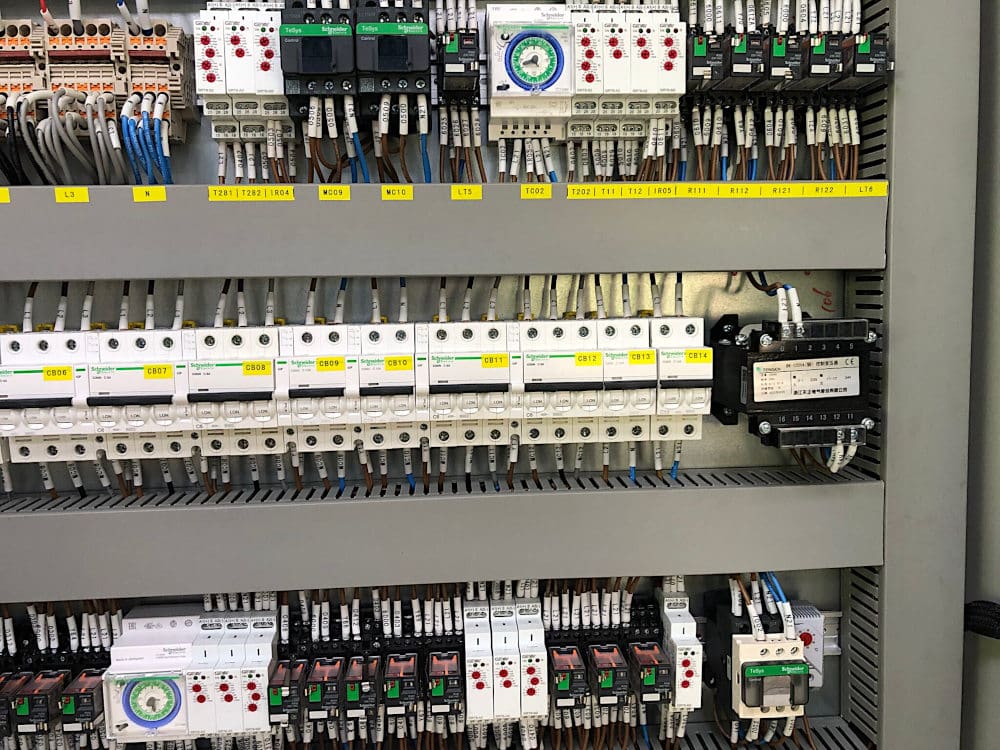
MCB (Miniature Circuit Breaker)
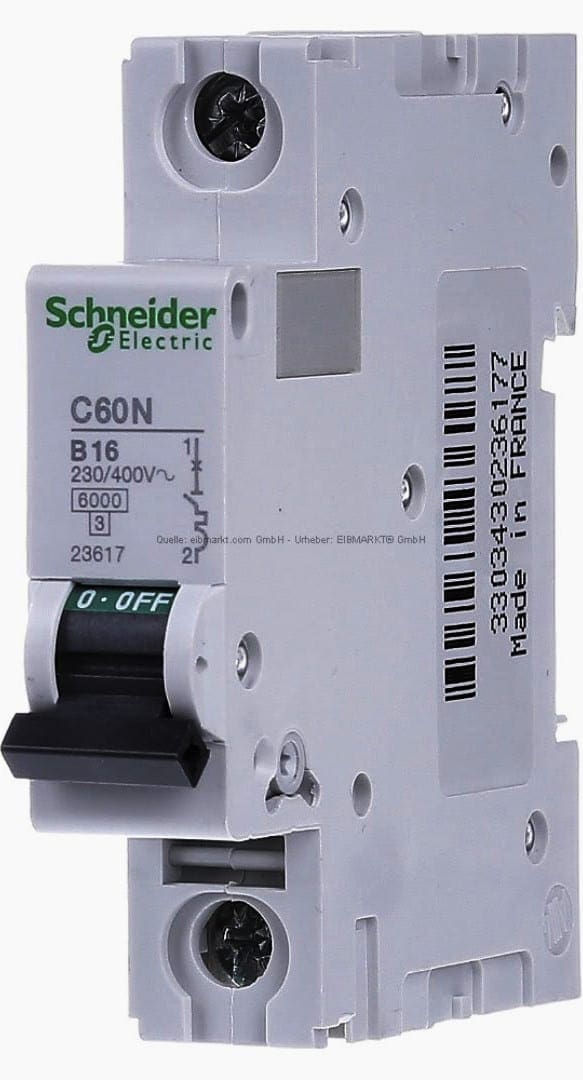
MCB Characteristics
- Rated current not more than 100 A.
- Trip characteristics normally not adjustable.
- Thermal or thermal-magnetic operation.
MCCB (Moulded Case Circuit Breaker)
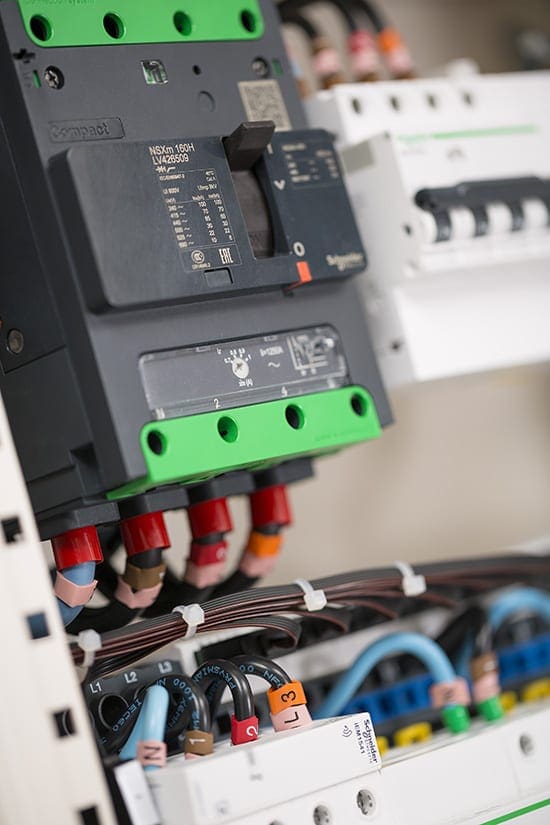
MCCB Characteristics
- Rated current up to 1000 A.
- Trip current may be adjustable.
- Thermal or thermal-magnetic operation.
Air Circuit Breaker (ACB)
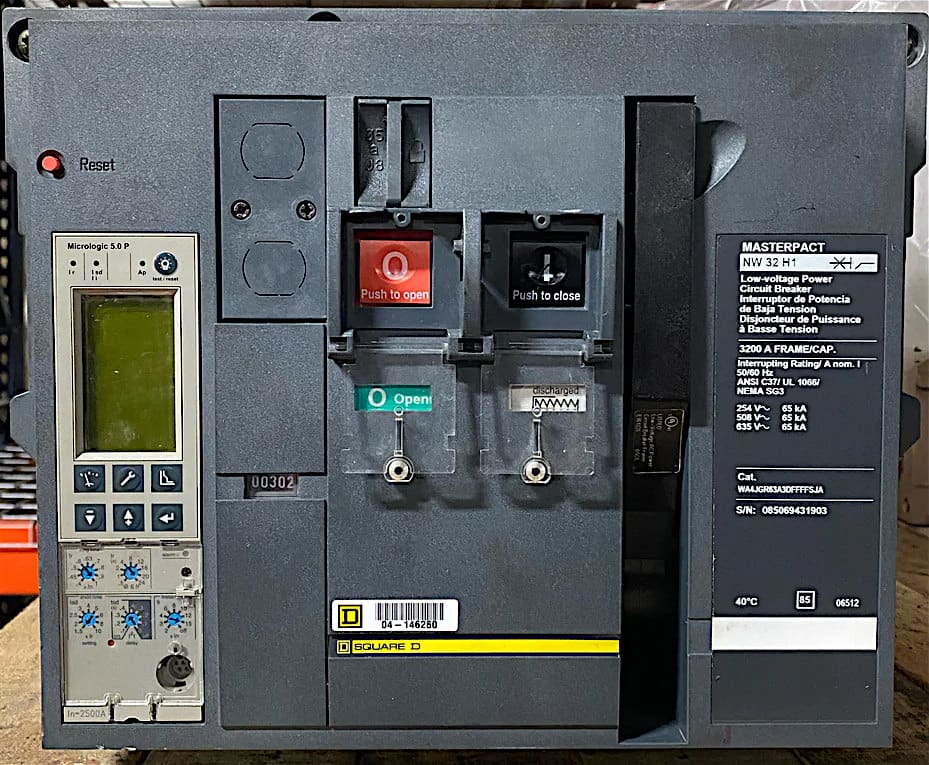
ACB Characteristics
- Rated current up to 10,000 A.
- Trip characteristics often fully adjustable including configurable trip thresholds and delays.
- Usually electronically controlled—some models are microprocessor controlled.
- Often used for main power distribution in large industrial plant, where the breakers are arranged in draw-out enclosures for ease of maintenance.
RCD (Residual Current Device / RCCB (Residual Current Circuit Breaker)
An RCD is a device engineered to protect people against electrocution or electrical fires by immediately interrupting the flow of electricity or triggering an alarm upon detecting a ‘leakage’ of electric current from a circuit. Understanding the significance of an RCD necessitates comprehension of the amount of electrical energy required to be fatal to a human person.
The minimum fuse utilized in a standard electrical plug is 3 Amps; it requires less than one-twentieth of that electrical current to be lethal to an adult in under one-tenth of a second.
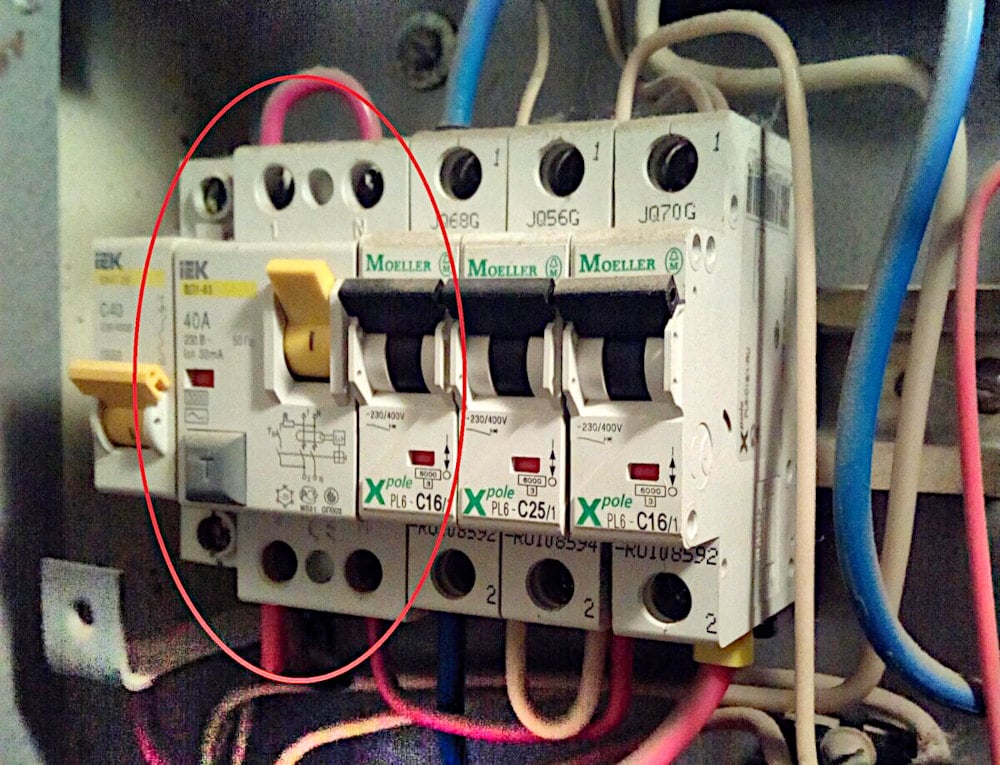
RCD/RCCB Characteristics
- Phase (line) and Neutral both wires connected through RCD.
- It trips the circuit when there is earth fault current.
- The amount of current flows through the phase (line) should return through neutral .
- It detects by RCD. any mismatch between two currents flowing through phase and neutral detect by -RCD and trip the circuit within 30Miliseconed.
- If a house has an earth system connected to an earth rod and not the main incoming cable, then it must have all circuits protected by an RCD (because u mite not be able to get enough fault current to trip a MCB)
- RCDs are an extremely effective form of shock protection
The most widely used are 30 mA (milliamp) and 100 mA devices. A current flow of 30 mA (or 0.03 amps) is sufficiently small that it makes it very difficult to receive a dangerous shock. Even 100 mA is a relatively small figure when compared to the current that may flow in an earth fault without such protection (hundred of amps)
A 300/500 mA RCCB may be used where only fire protection is required. eg., on lighting circuits, where the risk of electric shock is small.
Limitation of RCCB
- Standard electromechanical RCCBs are designed to operate on normal supply waveforms and cannot be guaranteed to operate where none standard waveforms are generated by loads. The most common is the half wave rectified waveform sometimes called pulsating dc generated by speed control devices, semi conductors, computers and even dimmers.
- Specially modified RCCBs are available which will operate on normal ac and pulsating dc.
- RCDs don’t offer protection against current overloads: RCDs detect an imbalance in the live and neutral currents. A current overload, however large, cannot be detected. It is a frequent cause of problems with novices to replace an MCB in a fuse box with an RCD. This may be done in an attempt to increase shock protection. If a live-neutral fault occurs (a short circuit, or an overload), the RCD won’t trip, and may be damaged. In practice, the main MCB for the premises will probably trip, or the service fuse, so the situation is unlikely to lead to catastrophe; but it may be inconvenient.
- It is now possible to get an MCB and and RCD in a single unit, called an RCBO (see below). Replacing an MCB with an RCBO of the same rating is generally safe.
- Nuisance tripping of RCCB: Sudden changes in electrical load can cause a small, brief current flow to earth, especially in old appliances. RCDs are very sensitive and operate very quickly; they may well trip when the motor of an old freezer switches off. Some equipment is notoriously `leaky’, that is, generate a small, constant current flow to earth. Some types of computer equipment, and large television sets, are widely reported to cause problems.
- RCD will not protect against a socket outlet being wired with its live and neutral terminals the wrong way round.
- RCD will not protect against the overheating that results when conductors are not properly screwed into their terminals.
- RCD will not protect against live-neutral shocks, because the current in the live and neutral is balanced. So if you touch live and neutral conductors at the same time (e.g., both terminals of a light fitting), you may still get a nasty shock.
Learn more about RCD:
Inevitable in almost all electrical switchboards – Residual current device (RCD)
Earth Leakage Circuit Breaker (ELCB) – old name for RCD or RCCB
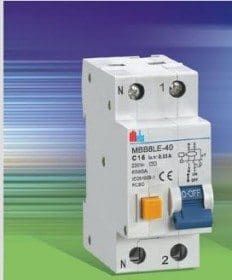
ELCB Characteristics
Formerly known as ELCB, this term is frequently used to designate to voltage-operated devices that are no longer available. If you come across such a device, it is strongly recommended that you replace it.
Let’s have a brief description of ELCB device:
- Phase (line), Neutral and Earth wire connected through ELCB.
- ELCB is working based on Earth leakage current.
- Operating Time of ELCB:
- The safest limit of Current which Human Body can withstand is 30ma sec.
- Suppose Human Body Resistance is 500Ω and Voltage to ground is 230 Volt.
- The Body current will be 500/230=460mA.
- Hence ELCB must be operated in 30maSec/460mA = 0.65msec
RCBO (Residual Circuit Breaker with OverLoad)
RCBO stands for a Residual Current Operated Circuit-Breaker with Integral Overcurrent Protection. It is possible to get a combined MCB and RCCB in one device (Residual Current Breaker with Overload RCBO), the principals are the same, but more styles of disconnection are fitted into one package.
A mechanical switching apparatus engineered to make, carry, and interrupt currents under normal operational conditions, and to activate the opening of contacts when the residual current reaches a predetermined threshold under specified circumstances. Furthermore, it is intended to provide protection against overloads and short circuits and can function independently of any other overcurrent protective device within its rated short-circuit capacity.
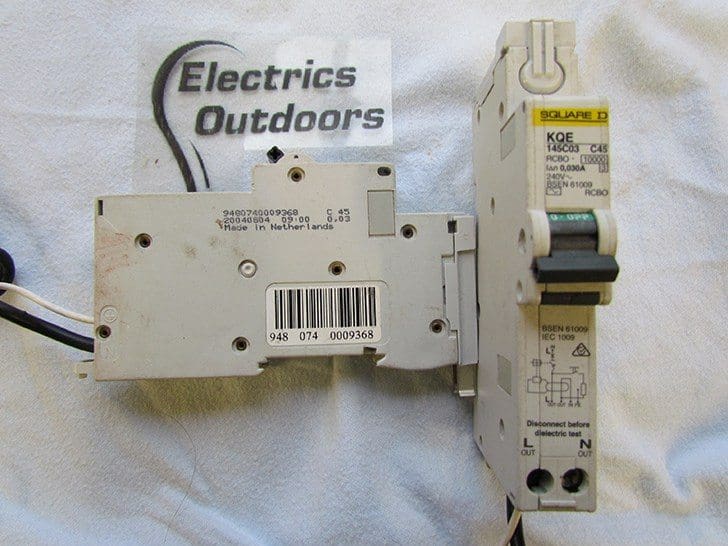
Difference between ELCB and RCCB
ELCB is the old name and often refers to voltage operated devices that are no longer available and it is advised you replace them if you find one. RCCB or RCD is the new name that specifies current operated (hence the new name to distinguish from voltage operated).
- The new RCCB is best because it will detect any earth fault. The voltage type only detects earth faults that flow back through the main earth wire so this is why they stopped being used.
- The easy way to tell an old voltage operated trip is to look for the main earth wire connected through it.
- RCCB will only have the line and neutral connections.
- ELCB is working based on Earth leakage current. But RCCB is not having sensing or connectivity of Earth, because fundamentally Phase current is equal to the neutral current in single phase. That’s why RCCB can trip when the both currents are deferent and it withstand up to both the currents are same. Both the neutral and phase currents are different that means current is flowing through the Earth.
- Finally both are working for same, but the thing is connectivity is difference.
- RCD does not necessarily require an earth connection itself (it monitors only the live and neutral). In addition it detects current flows to earth even in equipment without an earth of its own.
- This means that an RCD will continue to give shock protection in equipment that has a faulty earth. It is these properties that have made the RCD more popular than its rivals. For example, earth-leakage circuit breakers (ELCBs) were widely used about ten years ago. These devices measured the voltage on the earth conductor; if this voltage was not zero this indicated a current leakage to earth. The problem is that ELCBs need a sound earth connection, as does the equipment it protects. As a result, the use of ELCBs is no longer recommended.
MCB Selection
The first characteristic is the overload which is intended to prevent the accidental overloading of the cable in a no fault situation. The speed of the MCB tripping will vary with the degree of the overload. This is usually achieved by the use of a thermal device in the MCB.
The second characteristic is the magnetic fault protection, which is intended to operate when the fault reaches a predetermined level and to trip the MCB within one tenth of a second. The level of this magnetic trip gives the MCB its type characteristic as follows:
| Type | Tripping Current | Operating Time |
| Type B | 3 To 5 time full load current | 0.04 To 13 Sec |
| Type C | 5 To 10 times full load current | 0.04 To 5 Sec |
| Type D | 10 To 20 times full load current | 0.04 To 3 Sec |
The third characteristic is the short circuit protection, which is intended to protect against heavy faults maybe in thousands of amps caused by short circuit faults.
The capability of the MCB to operate under these conditions gives its short circuit rating in Kilo amps (KA). In general for consumer units a 6KA fault level is adequate whereas for industrial boards 10KA fault capabilities or above may be required.
Watch Video – How to choose right MCB
Fuse and MCB characteristics
- Fuses and MCBs are rated in amps. The amp rating given on the fuse or MCB body is the amount of current it will pass continuously. This is normally called the rated current or nominal current.
- Many people think that if the current exceeds the nominal current, the device will trip, instantly. So if the rating is 30 amps, a current of 30.00001 amps will trip it, right? This is not true.
- The fuse and the MCB, even though their nominal currents are similar, have very different properties.
- For example, For 32Amp MCB and 30 Amp Fuse, to be sure of tripping in 0.1 seconds, the MCB requires a current of 128 amps, while the fuse requires 300 amps.
- The fuse clearly requires more current to blow it in that time, but notice how much bigger both these currents are than the ’30 amps’ marked current rating.
- There is a small likelihood that in the course of, say, a month, a 30-amp fuse will trip when carrying 30 amps. If the fuse has had a couple of overloads before (which may not even have been noticed) this is much more likely. This explains why fuses can sometimes ‘blow’ for no obvious reason.
- If the fuse is marked ’30 amps’, but it will actually stand 40 amps for over an hour, how can we justify calling it a ’30 amp’ fuse? The answer is that the overload characteristics of fuses are designed to match the properties of modern cables. For example, a modern PVC-insulated cable will stand a 50% overload for an hour, so it seems reasonable that the fuse should as well.
Watch Video – Apparently its easy to install a consumer unit

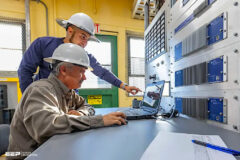
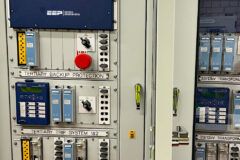



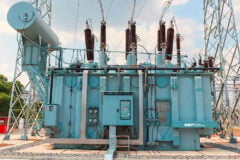

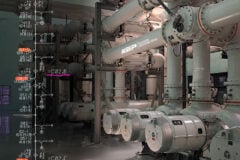


So what I’m getting is that if the current passing through a 30A rated MCB is 31A, it will not trip instantly, but will certainly do so after a certain amount of time, right?
In place where I live we do have high or low voltage issue at times. We are looking for recommendation on spec for eb panel in 3 storey residential unit. The sales guy is recommending for MCCB for ease of switching it ON back in case of tripping. Or TPN switch which blows immediately to protect equipment. Mcb is not recommended as by the time it trips, the damage is done. Let me know what is your recommendation. ?
We have 63A legrand DB box in each floor. And need recommendation on to use elcb or rccb or rcbo there ?
Main MCCB on each floor distribution panel
In addition on the floor distribution panels, RCBO on all final sub-circuits to accommodation
This will ensure safety and also ensure fault isolation and rectification quickly.
Working in Kuwait as Senior Electrical Technician for the last 10 years & various GCC country worked as an Electrical Foreman Ras gas Qatar qafco , Saudi Aramco & Safco ETC.
I’m electrician I Want to get more knowledge
Extremely useful information…Thanks!
Nice
Very well explained.
In depth, still lucid.
Am electrician in UAE Dubai , working,
I have liked the updates.
Thank you
Now am in UAE i Completed My First Degree By Electrical And Computer Engineering In 2016 At Ethiopia Country
Hello. Regarding to the circuit breakers acronyms, have you ever heard about mMCCB which is supossed different to the MCB and MCCB .. i got it in an tech spec
Thanks in advance
Thanks to much
Thanks Mr Jignesh for a well written blog. I have over 30 yr old wiring and very well calculated power distribution. But that time, RCCB were not available. Will take up change over sometime later, as suggested by you. Keep posting good articles. Thanks
Good Explanation……….
Tnx
Thank you for the article, absolutely well written and very helpful. My observation is on the line diagram presented for the fuse coordination, the first diagram B fuse value is 100A against 500A as explained and written on the second diagram. Please effect the correction on the diagram for easy flow of your explanation on the article.
Thank you.
Dear Jignesh,
Can i have your advice of RCCB suitable for EMC fan motor. Currently we has installed a 300mA RCCB by LS Electric type RKN but can’t find its spec related to super-resistant, characteristic K as recommend by factory. After we installed LS brand, the newly motor still trip quite frequently. Thanks
Thank you jignesh I really love the explanation
Thanks a lot
Good Explanation. MCB,MCCB,RCB,RCCB,RCBO,ELCB
This is just awesome. You explain everything in a single article. Thank you sir
Thanks of lot
Thank you Jignesh for your detailed information.
thank you very much for your wonderful education
Can you advice us ELCB is required if a MCB is attached.
AM LEARNING ALOT THANKYOU
Explain a case where both MCB and RCCB can trip.
why the RCCB live-neutral should not be reversed. Please explain
This is easy to understand for me.
Thank very much, Sir.
what You use ELCB or RCCB for own use
why not publish RCCB internal
Thanks so much for the explanation really appreciate
thank you for the clear explanation i will keep it at the back of my mind
Dear Sir,
Thank you very much for valuable information
Hola muy buena información.
Saludos.
In lt distribution system generally use fuse wires but they don’t blow off even conductor cut and fallen on Earth but at the same time when any one come into contact they Wii get shock some times even die why
its because the flow of current during a short circuit (neutral to phase) is higher than neutral to earth so the fuse will be blown suddenly.
Very useful for Electrical field.
Thanks for sharing with brief, simple, its operation and with its limitation. Highly appreciated with many thanks.
My freezer keep developing fault whenever I have a voltage drop despite it been connected to a stabilizer.what is the best protective device should I use.
Dear Sir,
Thanks for sharing great information .
really informative… thanks
difference between dc cable and ac cable
There is no difference and nothing as such. Only the voltage rating vary.
Example 1000V AC (always in rms) rating cable would be rated as approx 700V DC.
Hello.
Thanks for your work, it was very informative.
can you please explain how mcb mccb elcb are selected,
how ways of db are calculated
what is the reason of mcb burning & melting issue in a panel & how we can stop it
I hope to get some important electrical information from this site …m
due to the less rating as compare to actual current
GOOOD ISSUE
An MCB operates as an automatic switch that opens in case of excessive flow of current. It is essential to install MCBs for better control and secure system. There are number of MCBs available based on their breaking capacity. Know more at – Schneider Electric India. https://www.schneider-electric.co.in/en/product-range/61939-acti-9-xc60-mcbs/434816321-miniature-circuit-breaker/
why the colour of wire red ,yellow & blue in electrical ,any standard is required for electrical
sir,
what is difference between pole & phase
Hi,
1 phase of CB has 1 or 2 Poles to choose, (U can direct N or u can choose to disconnect both of P&N)
3 Phase is the same (Have 3 or 4 poles to choose)
can you recheck the ELCB calculations.I think there are some mistakes with the current calculaton and the time of operating as current=voltage/resistance but while calculating you considered resistance/voltage also check the value and unit of operating time you calculated.
Your Maths seems to be in error’.. ohms law is (voltage / resistance) not as you have it “500ohms / 230volts”
see the below extract from your text:
Quote ” The safest limit of Current which Human Body can withstand is 30mA sec.
Suppose Human Body Resistance is 500Ω and Voltage to ground is 230 Volt.
The Body current will be 500/230=460mA.
Hence ELCB must be operated in 30mASec/460mA = 65msec”
Hope you are able to revise accordingly
it strange how so many people missed this error.. on such a basic principle
he just permuted 230 and 500 but the values are correct
can any one help me with selecting the wire guage with respect to the load
What is the procedure to detect malfunctioning of RCCB/MCCB/MCB? What is the procedure to check the RCCB on installation ?
Completing installation of the RCCB and connection of incoming Phase and neutral wire as per marked ‘L’ & ‘N’ on RCCB than switch on main supply or TPN.
To test the RCCB you can push test Button as on marked “T”.
The RCCB will trip .
And after that you can also test it by test lamp/short phase an earth point at any socket plug,bulb holder and light points connector.
Thanks
hi i am a certified electrical inspector engineer and i have a testing instrument to check RCB according to IEC procedure. all installations have to be checked by this type of instrument at least every 5 years for normal housings and once a year for industrial and public places. some public places are even compelled by law to check twicw a year. you shall be surprised of how many RCB i find out of range after 4 to 5 years
according to manufactyrers instructions the test button MUST be pushed once a month. the RCB mechanical system tends to get stuck if not actuated for a long period
The first two photos are be reversed with the black GE circuit breaker being the molded case CB and the white IEC circuit breaker is the miniature circuit breaker.
hello sir
i need a just little help
from some days my area electric transformer is giving high voltage,and my house electric applicens are totally gone bad. is not working of this problem. so i need any solution for recover this problem,or any power load tripper from out side.
please give me a good and helpfull advice on my mail
thnking u
dear install voltage stablizer of 3kva in home for all wiring
hello jigneshbhai how are you? I am an electrical technician most of working in gulf countries like (shell),which are following IEC standard of E&I field. could you give me the any resources or bibalogy to knoe this IEC standard. moreover could you give me information about COMPEx training ?
Hello Asad,
I think the solution to your problem lies in re-strengthening the transformer neutral earthing. Please check the neutral connection at your home and its continuity upto transformer neutral point. Also check if there are any bad joints. A floating neutral always lead to a dangerously high voltage (with respect to neural/ground) in one or more phases in a 3-ph, 4-w system where the neutral is solidly grounded.
Thanks,much appreciated.
An attempt for a simple summary but unfortunately technically not very correct. MCCBs could be up to 3200 A e.g. Tmax T8 and could have also microprocessor based release, MCBs could be up to 160 A, etc. Anyway, this is not the biggest problem. The main difference between MCCB and ACB in their construction, which ensures also different performance, different service capabilities etc.
Really very useful technical information . Thanks Mr.Jignesh Parmar
very good information for me. thank you
Which is the best device to install at home? for avoiding shock & overload?
Just simply install a distribution board with RCCB (40 Amps) , MCB (6 amps) for each light ckts and MCB (16amp or 20amp) for each power ckts , like-minded fridge, AC, geyser etc.)
Connection must be proper with RCCB MCB’s.
If you have any confusion or needs more help than contact me through mail.
Thanks
It is all over if you forget Ohms law, ( Over) V before R Ohms law is Voltage divided by Resistance
Just simply install a RCCB(40 amps) and MCB’s (6amp or 10 amps for light ckts and 16amps or 20 amps for each power ckts.)
Thanks in advance.
Which is the best device to install at home? for avoiding shock & overload?
For Eg. Today there was overload of current & our fuse didnt trip insted tubelight, laptop charger, mobile charger, routher charger got burnt also after some time when i tried to check the mobile charger by connecting to mobile the mobile device had live current & i suffered small scock. Luckily tv & fridge got saved in the nick of time.
Pls suggest a good device
Avoid both over current and shock ELCB is most suitable for home.
in the name of God
that’s it
thanks alot ma
so useful
Why can a lower kA rated MCB be used downstream from a higher rated upstream fuse? How does the fuse limit the let through energy?
Very good information Sir…
Thanks
Nice Information Jignesh, does this mean that none of these (MCB/MCCB/ELCB/RCCB) protect the devices from high voltages coming from Grid. Voltages stabilizer provide stable output but not feasible to connect every appliance with this.
Is there any device which protects from high voltages from grid adding over load and shock features.
Any inputs on this is very much appreciated.
If i have power watts and voltage how to know current (ampere) calculate the current
I=P/V
Hi Sir,
May i know why MCB and RCCB tripped at the same time? What is the high chance of tripping in that situation? Please reply!
Dear Sir
The newly wiring system in my home got burn when electrical people are connecting the meters at ground level. what will be reason and which one of the following is the suitable for homes to protect appliances and human from fault current MCB, MCCB, RCCB, RCD, RCBO
hai
is there any device to control the use of electricity. something like when too much power is used circuit should break. plz suggest
thanks
Yes, You can control/restrict use of Electricity by using Meters with Output relay, which will trip MCB
Sir,
It’s very simple , you can use fuse for the high power.
Thanx for this online knowledge sharing
Dear Sir,
Please suggest for switchgear BIS certificate requirement.
Is BIS require for all switchgear like MBC,MCCB,RCCB…etc?
Hi, BIS required with details as follows:
MCB: IS 60898
RCCB: IS 12640 Part 1
RCBO: IS 12640 Part 2
MCCB IS is not Compulsary, IS 60947 /IEC60947-2
Hope this will suit to your requirements,
Thanks in advance,
Thanku ji to provide information about MCB’s.
Thank you very much. This article is more helped to know type of circuit breakers.
Dear Mr. Jignesh,
Excellent Efforts, I have following Suggestions for Improvements:
MCBs: Generally available upto 125A
MCCB: Picture shown is of MCB not MCCB
ACB: Available only upto 6300A,
Hope to update,
Thanks in advance,
hi…i’d like to asking for spesification….
how many ampere i should using the mcb for installation on elevator with max weight 600kg???
and the motor is using 7.5 kw with max ampere is 28 A…
please reply…
for a motor of 7.5kW with a maximum ampere of 28, use 40amp mccb
Harini Apartment, F2,First Floor, No:3/1515,Mugalivakkam Main Road, Madhanandhapuram, Chennai-600125.
Dear Qyiph Da Silva,
First of all, You have to define following in additions to provided,
Where do you want to install ? As incomer of Control Panel/or only for Motor Protection,
Ideal Selection Criteria:
MCB Rating in A= Load (Motor) Rating in A
In your case, Ideal selection is 32A for Control Panel, for only starter we have to use MPCB,
Hope it will suit to your requirements,
Do not hesitate to contact more information i required,
Regards,
Bhavin Patel
Good informnation
a 30-amp fuse will trip when carrying 30 amps. *will blown
thank you.. so much
please explain the working of 3phase RCCB
The neutral current is zero in case of balanced 3phase load, then how works RCCB
What is the difference between Earth Leakage Relay and Earth Leakage Circuit Breaker? Is it the operation? or maintenance wise?
Earth leakage relay or earth fault relay used to unit protection. (Like – in transformer etc)
Earth fault relay connected between phase and ground and it’s work to ground the over voltage.
ELCB used in wiring or appliances earth protection to trip the ckts if there is any connection phase with ground/earth.
Thanks in advance.
Nice and Useful information
Thanks
Nice Information…..Thank you…
Your calculation of the time an ELCB must trip is incorrect.
30maSec/460mA = 65msec
That is 65mS, not 0.65mS.
Its uses where give details MCB rccb etc
I am in the business of water pump. I want to protect our submersible water pumps up to1 HP, single phase. Can you advise what type of MCB, RCB or RCBO should be used by us for protecting our submerisble pump against short circuit in winding, overload. The full load current of our equipment is 3.6 Amp. Please suggest proper product with minimum space requirements.
HI, Specific to Pump protenction MCB/RCCB/RCBO can’t be used as it has not been designed for that, You can choose MPCB’s (Thermal Magnetic Type) for Pump Protection which has adjustable overload settings based on Pumps winding Class & initial starting Torque, We also have to consider Reaction of product during fault, which has been defined in Coordination (Type 1/Type 2/Total),
You can contact for further details if required,
Thanks in advance,
for 1 hp single phase motor, use 20 amp mccb fuji.
Good job
Good Job,please I want to know if it will be possible for me to download the materials and where I can do that,am using phone to check the information.thanks.
Appalling English explanation of how an RCCB (RCD) works.
Get electrical knowledge
Very good information Sir
thancks alot sir ……
Hi i’m Shwetank Dixit a student of volkswagen academy, Thanks for sharing so explain about electrical our citizen or country has very need to knowledge of hardware (electrical knowledge) as well as software also please more and more and some advance………like MPCB (Motor protection circuit breaker) and all that…….
I’m E&I engineer… thanks a lot for all these beneficial and valuable informations .
I have a question : in the AC circuits normally we use a protection fuse at the line and the neutral directly wired ..why in DC circuit need to use 2 fuse for both (+) &(-) wires.
Dear Jigneshbhai,
I stay at Mangalore and I am a layman as far as Electricity is concerned, earlier I was staying at Ahmedabad where the electricity was of good quality. Your article was very informative.Here in Mangalore many times I have noticed that after a power outage when the power returns, there is current in the neutral line. It may be due to faulty re-connection by the electricity linesman. At this time if any appliance is on, it gets fried, also we get a shock on touching the appliance. Some of my appliances were destroyed because of this. I would like to know if I can use Residual circuit device(RCD) to prevent damage to appliances or will a 3 pin adapter with fuse will help. Or is there any other device that can help prevent damage to appliances when there is current in Neutral( as tested with a screw driver tester). Power outage occurs here at least 3 times a day!!
Thanks in advance.
Pl.send detail ELCB
ELCB (Earth leakage circuit breaker)it is working based on Earth leakage current, The safest limit of Current which Human Body
EX:Many switch are connect in this ELCB circuit.any one switch to earth fault on human body touch on the time working ELCB is tripped.then totally off switch through to the ELCB circuit.this is ELCB function.
Thank you so much! Mr. Jignesh Parmar
I’m real aprisiate that electrical is every thing.. No electrical nothing can go on.
I WOULD LIKE TO THANK ALL WHO SHARE IN DEVELOPEMENT OF THIS SITE HOPE TOO MUCH PROGRESS AND ALL OF THEIRE DREAMS COME TRUE
i love Electrical….
very useful. Thanks for the information.
thanks very much useful information
But what about the earthing we use outside our home or commercial place? If we use RCCB ,really there is no use of earthing?
Basically it’s all a load of old toast
what is differential circuit breaker by 30ma. and what difference between mcb also
Nice artical just want to ask I have completed B.E.Electrical. Should I do M tech in power system ?
Well articulated explanations. Kudos
Thank you for the information
Our system in my province is Multi Ground – phase (live) and earth ( ground) without neutral. I recently purchased a Lighting panel in Australia fully assembled with RCCDs ..how can I adapt this to be used in a multi ground system where we have no established neutral? Please advise. I was thinking of doing this with a transformer but still want a cheaper fix
thanks
Thank u sir for giving me knowledge about MCB types.
Now I want information about power theft detection bcoz it is my final year project.
Please share information with me on my email. Thank u.
I am a Tanzanian man, electrical technician, thanks for your article
Dear Sir ,
I am working as maintenance Engineer ,
I have facing one problem our 4 pole RCCB incoming terminal are frequently overheat or burn out . What are are the causes behind that ?
Please guide and What should I check ?
RCDs detect an imbalance in the live and neutral currents. A current overload, however large, cannot be detected. It is a frequent cause of problems with novices to replace an MCB in a fuse box with an RCD. This may be done in an attempt to increase shock protection. If a live-neutral fault occurs (a short circuit, or an overload), the RCD won’t trip, and may be damaged. In practice, the main MCB for the premises will probably trip, or the service fuse, so the situation is unlikely to lead to catastrophe; but it may be inconvenient.
It is now possible to get an MCB and and RCD in a single unit, called an RCBO (see below). Replacing an MCB with an RCBO of the same rating is generally safe.
ELCB trip in over load yes or no?
A big NO NO NO
We relay Appreciate with you and getting knowledge in our typical situation thanks.
Sir I have done 12class and it good site
i am a second year ece engg student form NSIT
A clarification
Reference my comments and questions on May 18,2015, Please note while using a Test Pen on a Phase wire causing a small current to flow thru our body to Earth, resulting in a bulb glowing, a resistor is connected in series to drop the Phase voltage, making it safe to touch. In case of an appliance malfunction, where the Phase voltage is present on the casing, touching it may cause an electric shock.
The RCCB will operate and cut off supply to the load if there is an unbalance (or difference) in the currents flowing thru the Phase (Line or Live) wire and the Neutral wire. In the Malaysian system, all equipment and utensils ( esp. those made of metal), the body or casing is connected to an Earth wire, which originates from the Main Switch Board. In the unlikely event of the Phase wire coming into contact with the body of the appliance (e.g. a bread toaster), a leakage current will flow from the body of the appliance to Earth, causing an unbalance in the RCCB and forcing it to trip and isolate the load.
If an Earth wire system is not provided, the RCCB will trip only when a human touches the appliance, causing a current to flow thru him to Earth or Ground, resulting in an unbalance in the RCCB. An efficient RCCB needs to be sensitive to about 30mA leakage current and operate fast enough to avoid any hazard to the human.
Am I right? I believe this is not dangerous as when we use a Test Pen on the Phase wire, a small current does flow thru our body to Earth causing the lamp to light.
The doubt is whether the current thru our is the same in both instances.
Thank you and hoping for some clarification on this matter.
Sir I have b.tech pasout in this year I want you help me increase my Knowledge.i m very thankful
Thanks for the helpful information, please can you kindly help me with information on how MCCB, MCB, RCCB, ACB, VCB etc. circuit breakers are rated.
Pretty good read
I want extra knowledge in electrical engineering, so I want to subscribe your news letters
I want to gain extra knowledge about electrical engineering.so I want to subscribe your news letters.
Dear sir,
A beautiful explanation to understand all thanks
awaiting a lot from you!!!!!
Very simply and aptly explained. Superb.
Hi. You have a typo under the ELCB comments. “The Body current will be 500/230=460mA.” That’s upside down, of course, it’s 230/500.
Good post, by the way.
Right Paul, you are correct, as per ohm’s law V=IR so I=(V/R) in A, i.e. 0.46A
I= 460mA
Sir,
Thanks a lot for your topic.
May I ask you on how to connect MCB and RCCB in residential wiring? Should L n N wires from Main Switch be put into RCCB and then to MCBs ? How to connect those for Inverter lines?
What is different between B, C, D grade in MCB and which one do you recommend for rsidential purpose?For a 1.5 ton A.C. , what should be the grade and amp. of the MCB?
Please, help me.
You can use C type,,
Cheers
Steve
Nice Article
perfect
such kind of article ,generally not available,on site, it is very helpful.
thanks
very good and helping topic.
thanks
Dear Jignesh
I appreciate your valuable information.
Kamal Laha FIEAust CPEng LifeFIE(I)
Thank you sir for a very nice and useful artickle
impressive site
My rccb damaged & electrician has made electricity connection directly though mobs are there. Pl. advise me whether rccb is needed to install ? If i do not install rccb, what R the consequenc ?
MCB won’t cut the supply on an electrical shock to earth. Only a short from phase to neutral or overload it trips. So you should install rccb or elcb with 30mA best suits.
dear sir i appreciate your answer and your nature
please give me suggestion. i completed diploma in electrical
now i want to become a expertise in electrical field please suggest me
what i have to do
thanks and regards
kailash menaria
Sir why three point in battery terminal.
To take out two different volages. V2= 2 x V1
sir, what is the connection and working difference of ELCB and RCCB.
Thank you very much sir
Nice article…very useful..
good thinking..
Your picture of MCCB is not good ( it is a MCB) use a picture of NSX fron Schneider electric or similar.
Best regards
Thank u v.much Sir. I’ve few doubts.. V r constructing a 2BHK house in Chennai. Can i re-use a 4yr old (was working) 40A AUTO PHASE CHANGER? I also have 25A Rotary phase changers (say RPC) in a box, and in same DB box, 12 LeGrand MCBs (2x c20,4x c16, 2x c10, 4x c6) r there.
Shall i connect 3 parts/places(AC1, AC2, & Kitchen) to these RPCs via 63A RCCB in DB & again take back to DB & connect with MCBs?!! So that i can connect confidently all remaining divisions with AUTO-PHASE CHANGER.
Also i’ll be glad if i get a chance to talk with you rgdg it. Am not comfortable in txting…
Thank u
Sankar TL: 8015666550
I like electrical
Nice information…..
thank you bro for this information
Thank you sir for your complement. I will need more encouragement as a beginner.
dear Sir
appreciate your support to inform me what the reason for current leakage
we installed RCCB 300 mA at our site GEDP (contain-Air condition CB and light-socket-emergency light-rectifier… etc.
but RCCB down many times
Thank you sir
Thank you sir,
For this information
Dear jignesh,
We are using Mcb but in recently my oven blown due to over current even my oven switch was in off condition my advise me what typeople of protection device I should install, now a days hpl is advertising for over load current tripping mccb. Pl advise
ashok vastrad
Finally a clear understanding of rcd / rcbo, totally transfixed by your clear explanation and I want to learn more. I’ve been an electrician for 8 years and never bore of the devices we trust and how they work in a changing industry.
dear sir
please give me information about shock guard
i want to make it at home
so please give me suggestion with diagram
Hi ,Thank you for your valuable information
sir can you give the idea for this one,
due to some return current r short ckt or leakage current is or high voltage is accrued we r using mcb but all the device get damaged.
what kind of protective devices we can used to over come the problem
and how to control the over voltage isues
This is very much useful for me.
Thanks & Regards
Hi Jig, Thank u for the information..Recently i was attacked by electric shock and this time i felt the current flow entire body
Sir,
I read these article about circuit breakers.I can acuuired many knowledge about that.Thank you for the valuable Informations.
thanks & regards
JOBIN
PH: 08281124775
Very usefull
Dear Sir,
By reading your article today I understood all kinds of breakers and their difference. Thanks for your article. Allah bless you.
Really useful sir, helps me in procurement
very useful and unlike knlowdge
hi,
Thanks for the practical information you have shared, especially the difference between all the circuit breakers. now i got to understand the major difference between different kind of circuit breakers.
thanks again ….
Sir very useful at my sites
Sir I got More information.In ELCB calculation is 230/500=460MA
I learn lot from EEP .
how can!t i minimize the humming of circuit breaker
Most probable cause is some internal loose connections and or the loss of strong bonding between laminations of any magnetic path internal. Open out the breaker and look into
I’m electrical
engineer
Very useful for practical tips & latest information
i like the way you teach can you help me in adding my electrical am electrical craftman
Its very useful. Though i am mechanical engineer but i can understand the function of the devices easily you describe.
Heartily thanks Sir.
dear ji,
Could you explain me how to calculate the RCD rating in mA as my client is asking me to install 3P 150A Mccb with 300mA rating. I couldn’t find the list in the specification catalogue.
Ji,
MCCB has no mA rating. Only A rating. Rccb or Elcb has MA rating too. For safety side MA should be as minimum as possible, but also have to consider the grading between upstream and downstream mA also. If no downstream and upstream problems, like in small houses etc. Please select mA as minimum as possible. But some machines like submersible pumps will again trip as they have already leakage currents in small quantities. In that case increase the mA . Typical mA are 39, 50, 100 etc.
Nice,
I read it at a very timely instant, when I was installing MCB. Thanks a ton
Suhas
good
Thank you.
Its nice.
please make correct the spelling of “might” in characteristics of RCD/RCCB.
it’s not “mite”, its “might”.
What is the means rccb mcb mccb elcb rcco
Nice but increase the amount of pictures and try to explain by diagrams
Some how it’s helpful bt there is not enough discription…for elcb.
Thanks a lot for this information which is useful for safe precaution in projects …..Sinopec HSE Safety Eng
It’s really useful, but I am having small dout we using overhead crane in that we frequently facing drive failure. Below the hook welding work carried one also suggested the same ie due to welding operation Only these failure happened,any other cause????????
Hello,
Our main is connected through RCCB ,when i Tested the Earth with a bulb ,by connecting Neutral with Phase our RCCB tripped,but no problem with other devices.Is it ok?or something wrong with connection.
it’s really useful article to me . thank you so much
Nice and simple- way to go !!!
Nice job and well done
Its great thankss
thanks a lot Mr. PARMAR
Sir, i’m working in govt org. I have one problem. Our generator is turning off while running condition cause of unbalance load. Some people who using this load, they use water heater. We put the MCB 6 amp.in those circuit to reduse extra load. When 8-9 amp current flow throuw the mcb, it is not tripping. MCB condition is OK. Pls reply me.
please send me drawing of motor on/off every 5 minutes
I want a device which help in light cut between 160:260 voltageand shock proof suply
Complicated things made simple. You are making things easy for any engg studets /engineers to understand easily. Very nice.Easily digestable.Many a thanks. Regards Appu
it is very good ,useful and easily understandable information .
thanks for that .
i have question ,
which is modern medium used in circuit breaker for arc extinction ?
VERY USEFUL DEFINITIONS AND EASILY UNSTANDABLE.
Dear Sir,
Please explain me to how to select Barker for 20 KW load.
hello sir.
i our house there are new electronic meters installed, is there anyway i can reduse the speed of meter reading without tempering it..
in India we get A type MCB, whereas in all websites only 3 type B C D types are discussed.
How come A type is not discussed
I will be thankful if the same is clarified
dear sir,
you said that
For example, For 32Amp MCB and 30 Amp Fuse, to be sure of tripping in 0.1 seconds, the MCB requires a current of 128 amps, while the fuse requires 300 amps.
can you justify this statement ?
Hi thanks for the information provided for.
hi Jignesh I was following through ur various posts on meter bypass. I have a scenario on which I would like ur valuable expert comments. I live in a multi storied government quarter. I would like to know how to bypass the single phase electronic meter. It is giving me sleepless nights. Presently both the live and the neutral from the meter goes to a MCCB which then terminates in our flats DP.One option I am considering is like using 2 wires from one live phase from main connection. One goes through the meter and other directly to the house. Since distance from the meter to our house is considerable I cannot discreetly lay a new line to the flat I plan to disconnect the neutral in the MCCB and connect the unmetered live wire to the neutral port of the MCCB. In this way 2 wires both having the same phase would be coming to my flat from a single MCCB. We have 2 separate earth connections to the flat. For neutral I plan to use the earth wire. The second earth will be used for the three pin connections so that they are secured. The metered live phase could be used for some very low load to ensure meter running for atleast the minimum units. The unmetered phase will be used for rest of the loads. My query is-
1) Will the MCCB allow 2 live connections through it (both would of same phase so no 440 volts chance)?
2) Can I install a MCB with the earth which I would using as neutral. IF so, of how much rating.
3) What safety precautions should I take for preventing electrical shocks and equipment safety.
Pse reply fast.
With regards.
@Meter Manager
answers to your query:
1) don’t even try to do that. you can’t connect 2 feeder cables to one MCCB. one of the resons is electric shock at the start point of cable although its feeding circuit breaker is disconnected. but, you can connect 2 cables from MCCB and supply 2 or more consumers.
2) you can’t do that neither. if there is a RCD it will trip in that case, and earth conducter must not carry current in normal regime, only in case of fault.
3) use appropriate protection (MCB, MCCB, RCD, RCBO, etc), cable sizing to match equipment needs, and use of appropriate IP rating for environment where equipment is installed.
Very good information & to the point.
Good information. Great work Jignesh.
Dear sir,
i have doubt how does mcb trips. Is there any mechanisam is there in mcb to trip for certain rating plz reply me sir
Sir,
this is good information but i want 3 phase submersible pump’s ELCB/RCD Installation at agricultural basic so you sugges me in this both devices which is safe. Sugges me which capacity e.g 25a,63a for 3phase agricultural submersible pump.
every pump should have its own protection (RCD, RCBO, MCCB, ELCB, etc) and nominal current should be choosen on basis of pump’s power consumption and power factor.
1.I think this information is not correct. Because there do exist MCCB of 1,2,4,6,10,16,20,25,32,40,50,63 amperes of Schneider and even ABB……..
2. The figure which is shown(for MCCB) does not resemble to that of MCCB seems to be of MCB as per its looks.
3.Please follow the below links and correct me if I am wrong:
http://www.neweysonline.co.uk/neweys/pdf/Schneider_Electric_C60H_MCBs_Technical.pdf
http://www05.abb.com/global/scot/scot260.nsf/veritydisplay/530053f28668824f85257b6500708c05/$file/1SXU000023C0202%20RevA_17%20MCCB.pdf
Excellent
This is nice!thank u 4 dis!
want to know more abouy energy ditribution,d-regulation etc
I want to know LV design for building
Engineer ….not near engine
good
me want to know dat how to calculate the energy meter constant…with example…and hw to know dat multifly of mf
Thank you…
hi, sir i m working as a TFO in bank . require EE information.
thank you
This is really helpful. Thanx a lot.
Very helpful..simple to understand..thanks..
Very helpful..simple to understand..
thank u for providing knowledge
Brief, precise and superb information.
thanks for giving super information
Nice…
thanks a lot
thank you sir especially for the RCBO and the difference between ELCB and RCCB.
hopefully it is more then sufficient for my orals…….
IMHO
ELCB as above; under ‘Operating Time’ – the left side of the equation for ‘Body Current’ is upside down and gives an answer of 2.17 amps and not 460 mA as stated.
IIRC Ohms Law!
Thanks a lot
Thanks a lot, but I think that you should include the earthing systems which affect some products above.
BR
I liked all the topics listed above, based on my experience and usage of some of these equippments, i relaised that with ELCB, the current flow is better/optimistic in one direction and most preferrable for domestic applications. thanks for the article.
sridhar
Tjhanks a million…i just can’t tell u how much i needed dis…thanks a million….